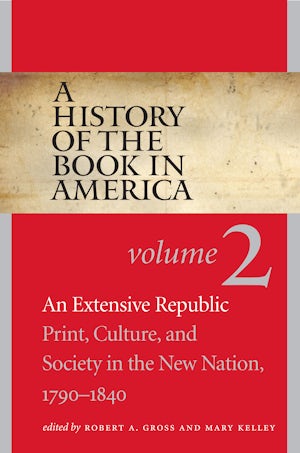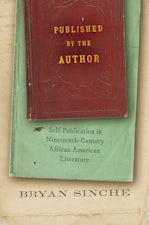A History of the Book in America
Volume 2: An Extensive Republic: Print, Culture, and Society in the New Nation, 1790-1840
Edited by Robert A. Gross, Mary Kelley
David D. Hall, General Editor
720 pp., 6.125 x 9.25, 66 halftones, 8 graphs, 12 tables, notes, index
-
Paperback ISBN: 978-1-4696-2161-6
Published: July 2014 -
E-book PDF ISBN: 979-8-8908-8245-5
Published: July 2010 -
E-book EPUB ISBN: 978-0-8078-9568-9
Published: July 2010
Buy this Book
- Paperback $66.00
- E-Book $29.99
For Professors:
Free E-Exam Copies
Awards & distinctions
A 2011 Choice Outstanding Academic Title
Between 1790 and 1840 printing and publishing expanded, and literate publics provided a ready market for novels, almanacs, newspapers, tracts, and periodicals. Government, business, and reform drove the dissemination of print. Through laws and subsidies, state and federal authorities promoted an informed citizenry. Entrepreneurs responded to rising demand by investing in new technologies and altering the conduct of publishing. Voluntary societies launched libraries, lyceums, and schools, and relied on print to spread religion, redeem morals, and advance benevolent goals. Out of all this ferment emerged new and diverse communities of citizens linked together in a decentralized print culture where citizenship meant literacy and print meant power. Yet in a diverse and far-flung nation, regional differences persisted, and older forms of oral and handwritten communication offered alternatives to print. The early republic was a world of mixed media.
Contributors:
Elizabeth Barnes, College of William and Mary
Georgia B. Barnhill, American Antiquarian Society
John L. Brooke, The Ohio State University
Dona Brown, University of Vermont
Richard D. Brown, University of Connecticut
Kenneth E. Carpenter, Harvard University Libraries
Scott E. Casper, University of Nevada, Reno
Mary Kupiec Cayton, Miami University
Joanne Dobson, Brewster, New York
James N. Green, Library Company of Philadelphia
Dean Grodzins, Massachusetts Historical Society
Robert A. Gross, University of Connecticut
Grey Gundaker, College of William and Mary
Leon Jackson, University of South Carolina
Richard R. John, Columbia University
Mary Kelley, University of Michigan
Jack Larkin, Clark University
David Leverenz, University of Florida
Meredith L. McGill, Rutgers University
Charles Monaghan, Charlottesville, Virginia
E. Jennifer Monaghan, Brooklyn College of The City University of New York
Gerald F. Moran, University of Michigan-Dearborn
Karen Nipps, Harvard University
David Paul Nord, Indiana University
Barry O'Connell, Amherst College
Jeffrey L. Pasley, University of Missouri-Columbia
William S. Pretzer, Central Michigan University
A. Gregg Roeber, Pennsylvania State University
David S. Shields, University of South Carolina
Andie Tucher, Columbia University
Maris A. Vinovskis, University of Michigan
Sandra A. Zagarell, Oberlin College
Published in association with the American Antiquarian Society
About the Authors
Robert A. Gross is James L. and Shirley A. Draper Professor of Early American History at the University of Connecticut. He is author of The Minutemen and Their World.
For more information about Robert A. Gross, visit
the
Author
Page.
Mary Kelley is Ruth Bordin Collegiate Professor of History, American Culture, and Women's Studies at the University of Michigan. She is author or editor of several books, including Learning to Stand and Speak: Women, Education, and Public Life in America's Republic (UNC Press).
For more information about Mary Kelley, visit
the
Author
Page.
Reviews
"With thirty-two contributors, this volume is a feat of compilation and editing."--Times Literary Supplement
"These superb essays convey the extraordinary range of possibilities in Americans’ interactions with print between 1790 and 1840."--Journal of American History
"The scholarship is up-to-date in every way, as the contributors (many leading scholars on their subject) look at every facet--human and machine--of producing the written word. . . . Gross and Kelley provide lucid, helpful overviews in their introductions to the book as a whole and to its six sections. No other single book offers such a rich and comprehensive analysis of how the written word helped shape antebellum America, and the series as a whole is magnificent. . . . Essential."--Choice
"Has a remarkable unity of voice, its sections elegantly knitted together by thoughtful introductions. . . . Both lay and academic readers . . . [will] be rewarded with the feeling of truly understanding the era, benefiting from both broad strokes and fine details."--Library Journal
"A model of scholarly publication and institutional cooperation. . . . A timely achievement and a great one. . . . Without university presses, we would still be waiting for HBA."--Journal of Scholarly Publishing
"The decision to plumb as many themes of print culture as possible, coupled with the skillful use of various rhetorical devices . . . has produced a volume that meets the challenge of coming to grips with a history of American printing that is more variegated than in any other society or culture of the period. . . . Eminently successful, and as in all good history it flings open doors for new avenues of research and understanding." --Printing History




